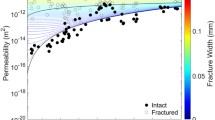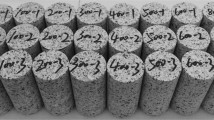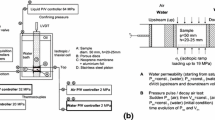Abstract
Fluid flows in consolidated porous media of volcanic origin are being investigated to support such diverse efforts as the modeling of thermal/outgassing phenomena at Mount St. Helens and the hydrological modeling of tuffaceous rocks in support of the Department of Energy’s (DOE) Nevada Nuclear Waste Storage Investigations Project An experimental apparatus was designed and built to allow water-saturated permeabilities as low as 10−18 m2 to be measured on cores of diameter 5 cm and length 10 cm under steady-state flow conditions. This same apparatus can also be utilized in a transient (pressure-decay) mode in order to measure permeabilities several orders of magnitude lower than the steady-state limit.
Tests were conducted on samples of pumice, fractured welded tuff, and welded tuff, representing a permeability range of seven orders of magnitude Pumice was found to have a permeability of ∼3×10−12 m2, sufficiently high to allow the complete Darcy-to-Ergun regime to be investigated Welded (unfractured) tuff was tested in the transient mode, yielding a permeability of ∼5×10−19 m2. Two, long-time-scale, steady-flow experiments were conducted on a core of welded tuff containing a single, through-going fracture. For the first experiment, the core was an integral cylinder containing a naturally occurring fracture. For the second experiment, the core was separated into two pieces along the existing fracture plane, then rejoined. Effects of essentially constant, as well as rapidly varied, circumferential stress were studied in both tests. Results showed core permeability to decay to 2×10−18 m2 in both cases, independent of the initial fracture state (closed versus open). With a naturally occurring fracture, core permeability decreased by a factor of 2 over a 200-h test period. With an initially open fracture, core permeability decreased by a factor of 4 under the influence of a comparable 200-h load-time history, after 700 h of testing, core permeability was reduced by an order of magnitude from its initial level. Final effective hydraulic fracture aperture was calculated to be 10−6 m, corresponding to a calculated effective fracture permeability of 10−13 m2 Fracture flow was thus estimated to account for 80% of the total flow rate through this core under final test conditions.
Similar content being viewed by others
References Cited
Bird, R. B., W. E. Stewart, and E. N. Lightfoot, 1960, Transport phenomena: New York, John Wiley & Sons, Inc.
Burnham, C. W., J. R. Holloway, and N. F. Davis, 1969, Thermodynamic properties of water to 1000°C and 10,000 bars: Geological Society of America, Special Paper No 132.
Collins, R. E., 1976, Flow of fluids through porous materials: Tulsa, The Petroleum Publishing Co.
Engelder, T. and C. H. Scholz, 1981, Fluid flow along very smooth joints at effective pressures up to 200 megapascals: Mechanical Behavior of Crustal Rocks, Geophysical Monograph 24, American Geophysical Union
Ergun, S., 1952, Fluid flow through packed columns: Chemical Engineering Progress, v. 48, no. 2, p. 89–94.
Gale, J. E., 1975, A numerical field and laboratory study of flow in rocks with deformable fractures: Ph.D. Thesis, University of California at Berkeley.
Gale, J. E., 1982, Assessing the permeability characteristics of fractured rock: Geological Society of America, Special Paper No. 189, p. 163–181.
Iwai, K., 1976, Fundamental studies of fluid flow through a single fracture: Ph.D. Thesis, University of California at Berkeley
Kranz, R. L., A. D. Frankel, T. Engelder and C. H. Scholz, 1979, The permeability of whole and jointed barre granite: Int. J. Rock Mechanics, v. 16, p. 225–234.
Morrow, C., D. Lockner, D. Moore, and J. Byerlee, 1981, Permeability of granite in a temperature gradient: J. Geophysical Research, v. 86 no. B4, p. 3002–3008.
Morrow, C., D. E. Moore, and J. D. Byerlee, 1983, Permeability and pore-fluid chemistry of the bullfrog tuff in a temperature gradient: 24th U.S. Symposium on Rock Mechanics, Assoc. of Engineering Geologists, p. 819–827.
Reynolds, O., 1883, An experimental investigation of the circumstances which determine whether the motion of water shall be direct or sinuous, and the law of resistance in parallel channels: Phil Trans. Royal Society, v. 174, p 935–982.
Schlichting, H. 1979, Boundary-layer theory: New York, McGraw-Hill.
Summers, R., K. Winkler, and J. Byerlee, 1978. Permeability changes during the flow of water through westerly granite at temperatures of 100°–400°C: J. Geophysical Research, v. 83, no B1, p. 339–344.
Taylor, B. E., J. C. Eichelberger, and H. R. Westrich, 1983. Hydrogen isotopic evidence of rhyolitic magma degassing during shallow intrusion and eruption: Nature, v. 306, no. 5943, p. 541–545.
Trimmer, D., 1982, Laboratory measurements of ultralow permeability of geologic materials: Rev Sci. Instrum., v. 53(8), p. 1246–1254.
Witherspoon, P. A., J. S. Y. Wang, K. Iwai, and J. E. Gale, 1980, Validity of cubic law for fluid flow in a deformable rock fracture: Water Resources Research, v. 16, p. 1016–1024.
Author information
Authors and Affiliations
Rights and permissions
About this article
Cite this article
Reda, D.C., Hadley, G.R. Saturated permeability measurements on pumice and welded-tuffaceous materials. Environ. Geol. Water Sci 8, 137–145 (1986). https://doi.org/10.1007/BF02509901
Issue Date:
DOI: https://doi.org/10.1007/BF02509901




